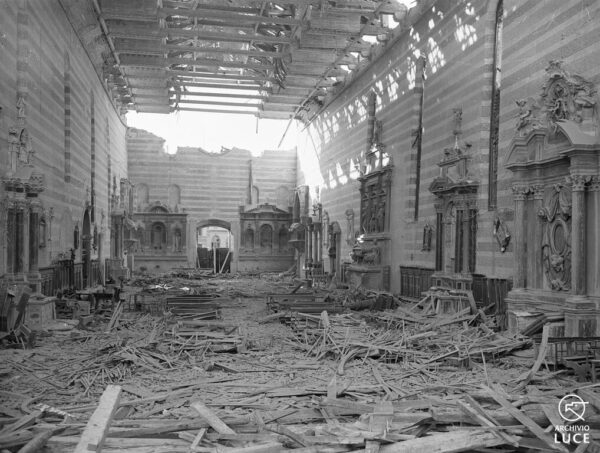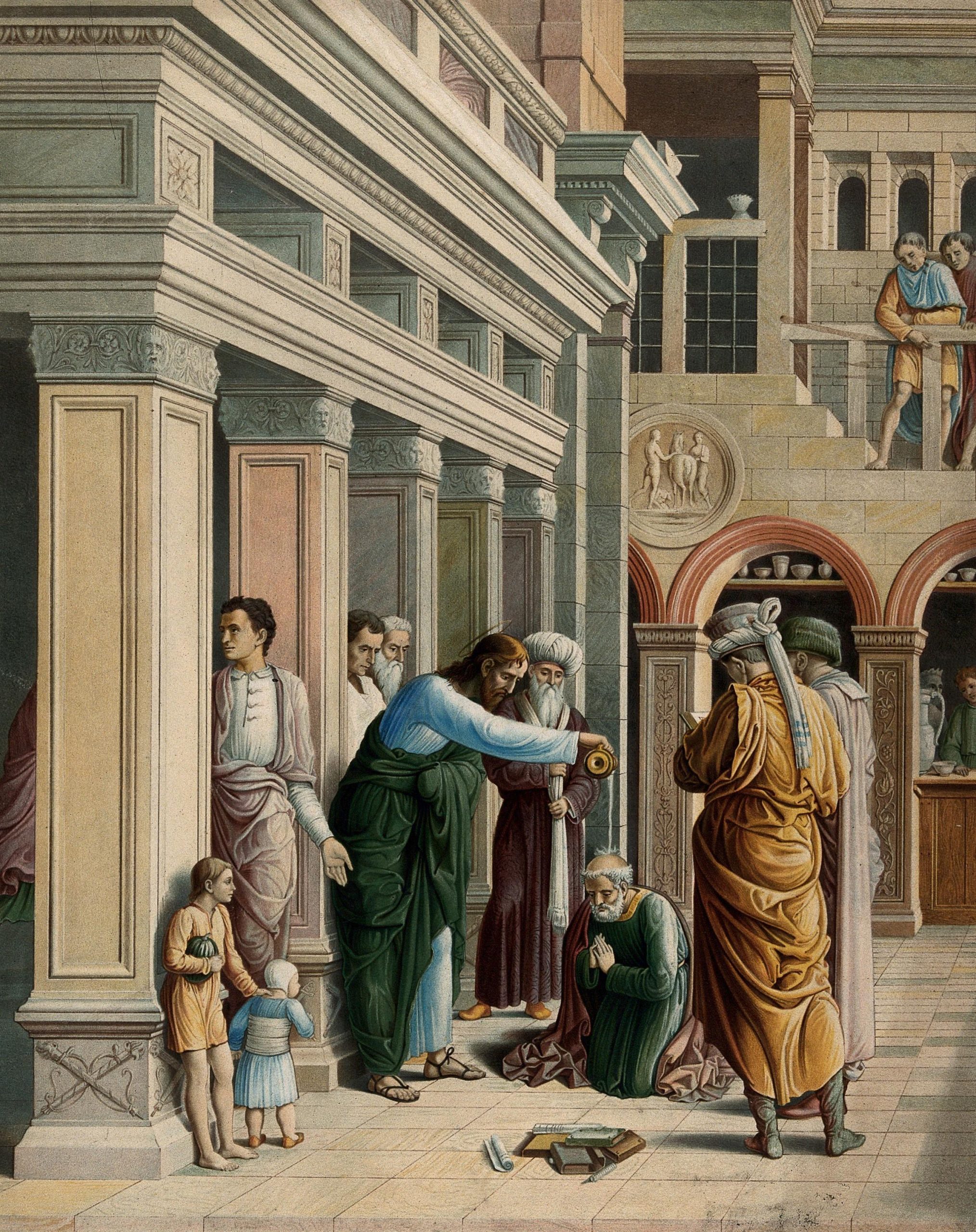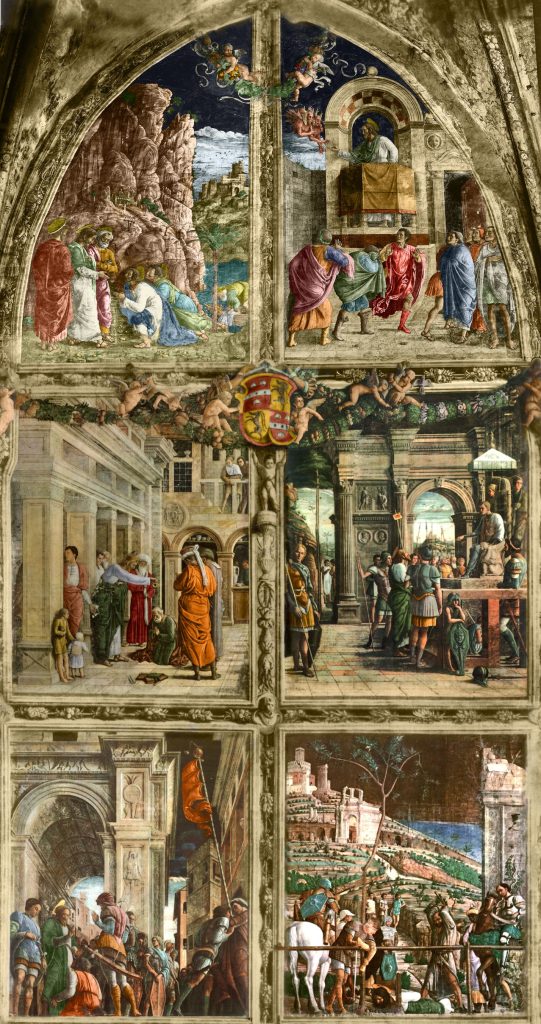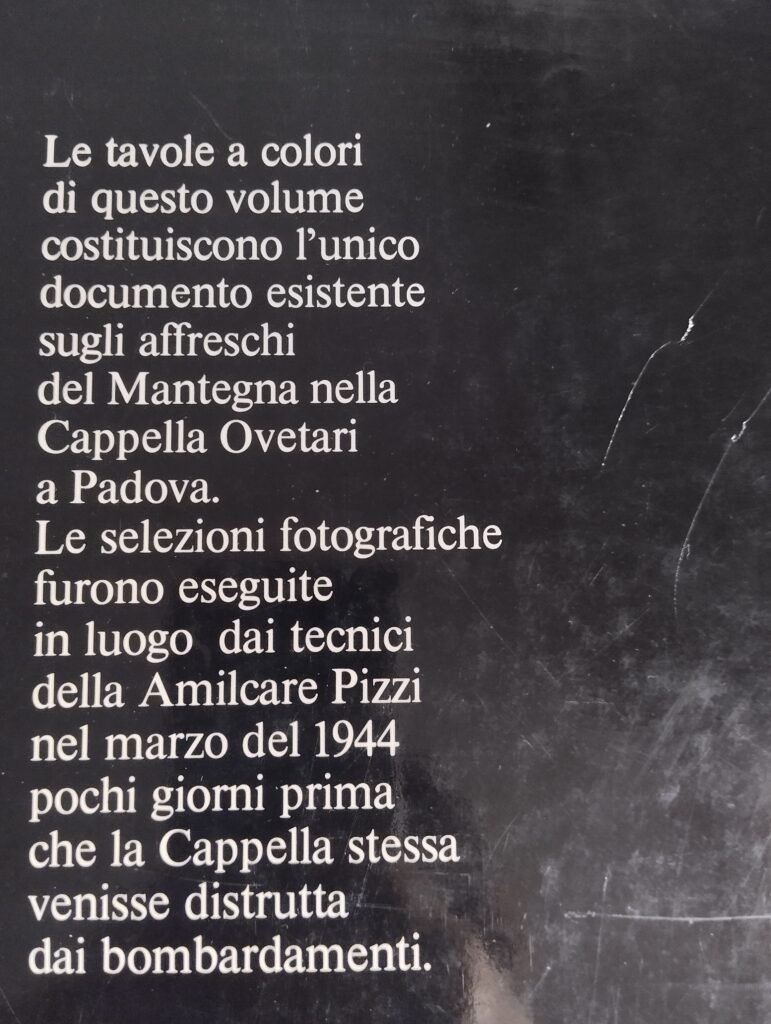A fresco in a case

“In the air raid of the 11th of March, 1944, the Ovetari Chapel was razed to the ground and only The Assumption, and The Martyrdom of St. Christopher, painted by Andrea Mantegna were saved, having been detached the wall in the previous century and put in a place of safety. This is surely one of the most tragic announcements that has ever been declared in the whole of the history of Art, and indeed this, and the burning of the Campo Santo at Pisa, involving the almost complete loss of all the Benozzo Gozzoli frescoes, represent the two major disasters of this war”. Vittorio Moschini wrote this note at the conclusion of his monograph dedicated to Andrea Mantegna.
The bombing had affected the church of the Eremitani in Padua.The air raid took place at about 11.30 in the morning of the 11th, a group of bombs fell; one on the facade and the front part of the roof, destroying the upper part of the west front; and the other fell on and destroyed the Ovetari chapel completely.
The frescoes of Andrea Mantegna were destroyed and reduced in dust and small pieces, and what could be saved, was put in eighteen cases.

Andrea Mantegna, Niccolò Pizzolo and Giovanni d’Alemagna
The notary Antonio Ovetari left a large sum of money for the decoration of the family chapel in the church of Eremitani in Padua. His widow Imperatrice Ovetari in 1448 commissioned a heterogeneous group of artists, Giovanni d’Alemagna, Antonio Vivarini from Murano, and the younger Nicolò Pizzolo and Andrea Mantegna to decorate her chapel. The painter Andrea Mantegna was at the beginning of his career, but he was already important as an artist, so that he received many commissions. Nicolò Pizzolo was an artist with a marked ability to render an almost sculptural volume to the painted figures. In the original project, Antonio Vivarini had to paint the arch with Stories of the Passion of Christ, which was never executed, the cross vault and the right wall ( Stories of San Cristoforo ) and the rest, that is, the left wall ( Stories of San Giacomo Maggiore) and the apse.
In 1450 Giovanni d’Alemagna died, he just had time to paint only the decorative festoons of the vault, and shortly afterwards, in 1451 Antonio Vivarini who had painted the four Evangelists on the vault , also abandoned the work . They were replaced by Bono da Ferrara and Ansuino da Forlì.
Between the 1443 and the 1454 Padua was one of the city protagonist of the Renaissance in the Veneto region: Donatello and Andrea Mantegna were working in the city.
The Ovetari chapel was – and it is – a very important Italian Renaissance work of art.

Ferdinando Forlati
Ferdinando Forlati, the architect responsible for the main restoration work, carried out after World War II in the Veneto region, restored the Eremitani church and Ovetari Chapel.
The presbytery of the church had collapsed, as had a portion of the facade. The nave was seriously damaged, and the adornments of the interior were all irreparably lost. The masonry surviving the collapse presented off-plumbs ranging from 32 cm to 50 cm. The stage consisting in collecting the debris began immediately in order to recover fragments of Mantegna’s frescoes, above all. Following the war, the fragments were delivered in 109 cases to the Istituto Centrale del Restauro in Rome, headed at that time by Cesare Brandi. Here, repair work was carried out, with the lacunae integrated by adopting the «tecnica del rigatino».
During reconstruction, all the elements recovered were placed alongside new elements in stone or brick on which the date of reconstruction was engraved, separated from the surviving parts by a black groove, in order to indicate the limits of the collapse.

The new restoration in 2006
The fragments of the frescoes, amounting to many tens of thousands (aproximately 80.000), had been placed in special crates and stored in the Civic Museum. Sixteen years ago the local University and the Soprintendenza dei Beni Architettonici del Veneto Orientale, with the financial support of the Fondazione Cassa di Risparmio di Padova e Rovigo, which has invested 950,000 euros, decided to carry out an innovative intervention on the Chapel. Thanks to sophisticated computer techniques, the south wall was restored by recreating the image of the frescoes using a life-size digital photo and applying all the identifiable fragments, thus restoring to visitors the appearance of the Chapel as it was at the time of Mantegna. At the same time, work was also carried out on the architectural part by lowering the floor level and eliminating the access steps added at a later date, and moving the high altar to the original position from which it was removed in 1931. Lastly, the bas-relief of the altar frontal was restored. This work was carried out by architects Anna Maria Spiazzi and Edi Pezzetta.


The horrible massacre
In his book dedicated to the Eremitani church, written in collaboration with Maria Luisa Gengaro, Ferdinando Forlati wrote: ” The Church of the Eremitani was a remarkable monument, and its destruction is an irreparable loss to the beauty of the world. Even if it were possible to reconstruct, when war is over, the architectural whole of the Church, nothing could give us again the paintings of the tribune, of the great apse, of the Cappella Dotto, and above all those of the Cappella Ovetari. But if such a sacrifice were to make mankind wiser and more cautious in unchaining the terrible scourge of war, one would hope that such a horrible massacre might not have been made in vain”.
If you desire to discover Art and Architecture, contact me.
link to the Italian version ‘Il bombardamento della chiesa degli Eremitani a Padova‘
@ Copyright holder 2025 All rights reserved. No part of this publication can be reproduced, stored in a retrieval system or transmitted in any form or by any means, electronic, mechanicanical or photocopying, recording, or otherwise without the prior permission of the publisher.
